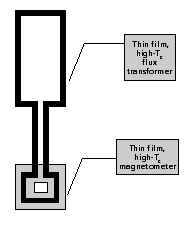Ernest Orlando Lawrence Berkeley National Laboratory
APPLICATIONS OF TECHNOLOGY:

New squid-based asymmetric planar gradiometer detects minute changes in local magnetic fields, even while operated amidst ambient magnetic field noise. This ability to suppress ambient magnetic field noise is necessary to detect magnetic signals generated by the human heart or brain in unshielded environments.
- Enabling technology to allow SQUID-based sensors work in unshielded environments
- SQUID-based sensors applications:
- Non-invasive medical imaging
- Non-destructive evaluation of materials
ADVANTAGES:
- Increase S/N ratio by factor of at least 1000
- Lower manufacturing cost
ABSTRACT: This novel, superconducting, asymmetric, planar gradiometer designed by John Clarke and colleagues at Berkeley Lab detects minute changes in local magnetic fields, even while operated amidst ambient magnetic field noise. When combined with the Lab’s SQUID devices to reduce intrinsic magnetic noise, the suppression of ambient magnetic field noise is the next step toward the successful operation of squid-based instruments in unshielded environments. The new asymmetric gradiometer increases the signal-to-noise ratio of small sources in the earth’s magnetic field by at least 3 orders of magnitude. It only has a single layer of superconducting YBCO film, and should be relatively inexpensive to manufacture, even with long baselines used for medical applications. This device is sensitive enough to pick up biomagnetic signals, generated, for example, by the human heart or brain. Other potential applications include nondestructive evaluation of materials.
STATUS:
- U.S. Patent #6,154,026
- Available for licensing
REFERENCE NUMBER: IB-1298
FOR MORE INFORMATION, SEE:
SEE THESE OTHER BERKELEY LAB TECHNOLOGIES IN THIS FIELD: